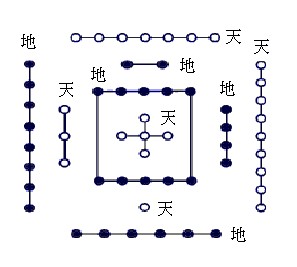河圖洛書

〈河圖〉

(插圖 1 - 龍馬)
河圖相傳為伏羲氏在黃河的龍馬獸背上發現之點狀成圖,我們可試用另一角度看看這圖之結構,其間所藏之學理。陽奇陰偶,天陽地陰。其間天一生水,地六成之,故一六共宗。地二生火,天亡成之,故二七同道,天三生木,地八成之,故三八為朋,地四生金,天九成之,故四九為友。天五生土地,十成之故五十同途。河圖之理,一生一成,陰陽交互,乃地理之源,亦天運之本。而河圖有理氣而無方位,有體質而無運用。
〈洛書〉

(插圖 2 - 神龜)
洛書相傳為夏禹治水時期發現神龜背之紋理而創,神龜不知是否訛傳。但洛書盤中所包涵的學問,非一時可理解,洛書盤口訣,載九覆一,左三右七,二四為肩,六八為足。
Yellow River Diagram and Luo Shu Chart
According to ancient Chinese myths, the sage Emperor Fu Xi once saw a “Dragon horse” coming out from the waters of the Yellow River, and he was inspired by the white and black dots on its back. Based on the pattern of these dots, he derived the Chinese numerology, which later developed into the Yellow River Diagram. Uneven numbers are yang in nature, and are referred to as the heaven.
Even numbers are yin, and are referred to as the earth. One and six together, as water, reside in the north. Two and seven, as fire, reside in the south. Three and eight, as wood, reside in the east. Four and nine, as metal, reside in the west. Five and ten, as earth, reside in the centre. These numeral symbolize the interaction between yin and yang, and they become the basis for the later development of Chinese metaphysics.
There was another legend that the sage emperor Yu, founder of the Xia dynasty, was inspired by the marks on the back of a mysterious turtle in the Luo River. From the arrangement of these marks, he created the Luo Shu Chart. It showed that the numeral nine is at the head and one is at the tail (of the turtle). Three is on the left side and seven is in the right side. Two and four are the right and left shoulders; six and eight are the right and left feet. Five occupies the centre.


